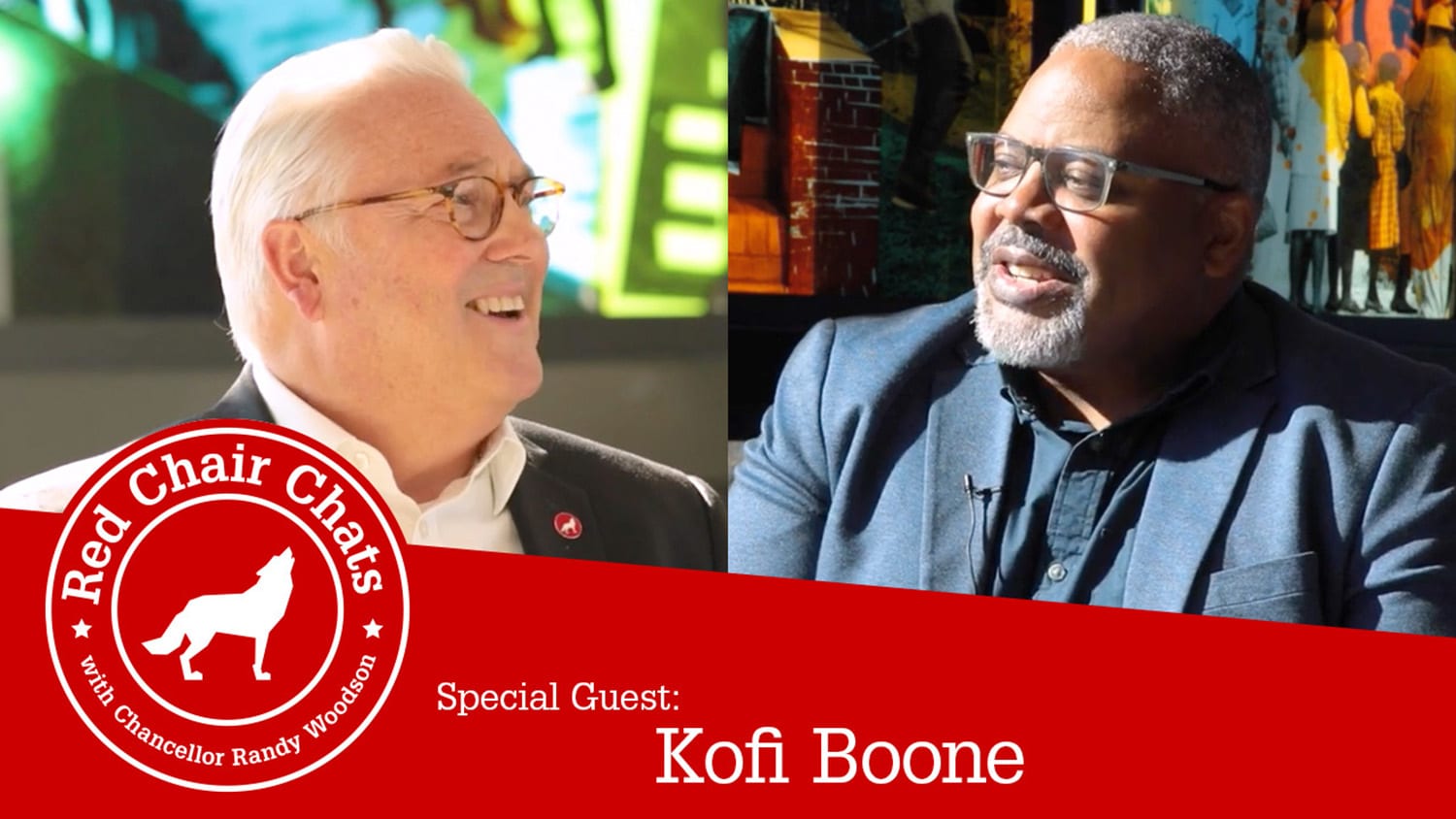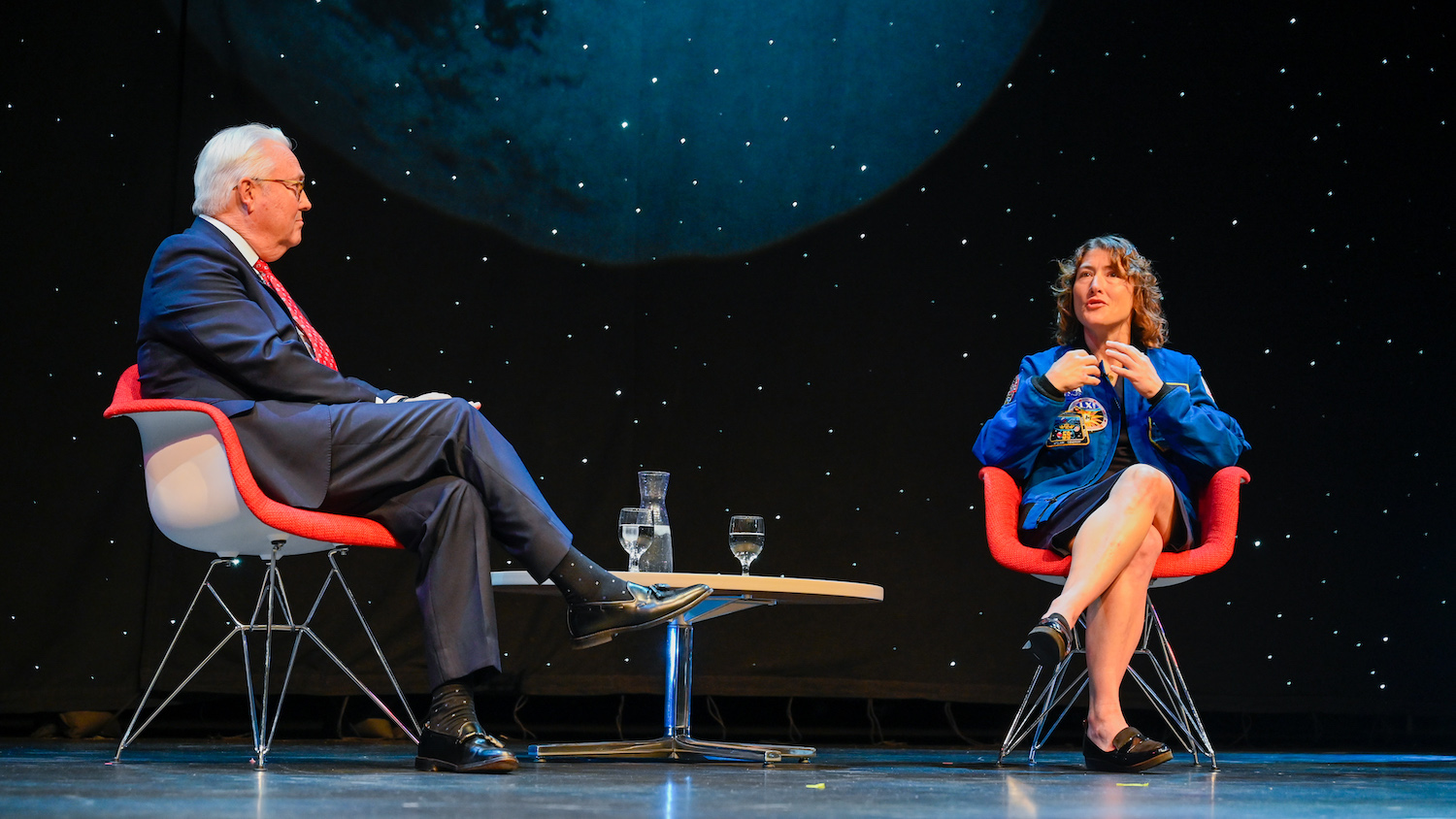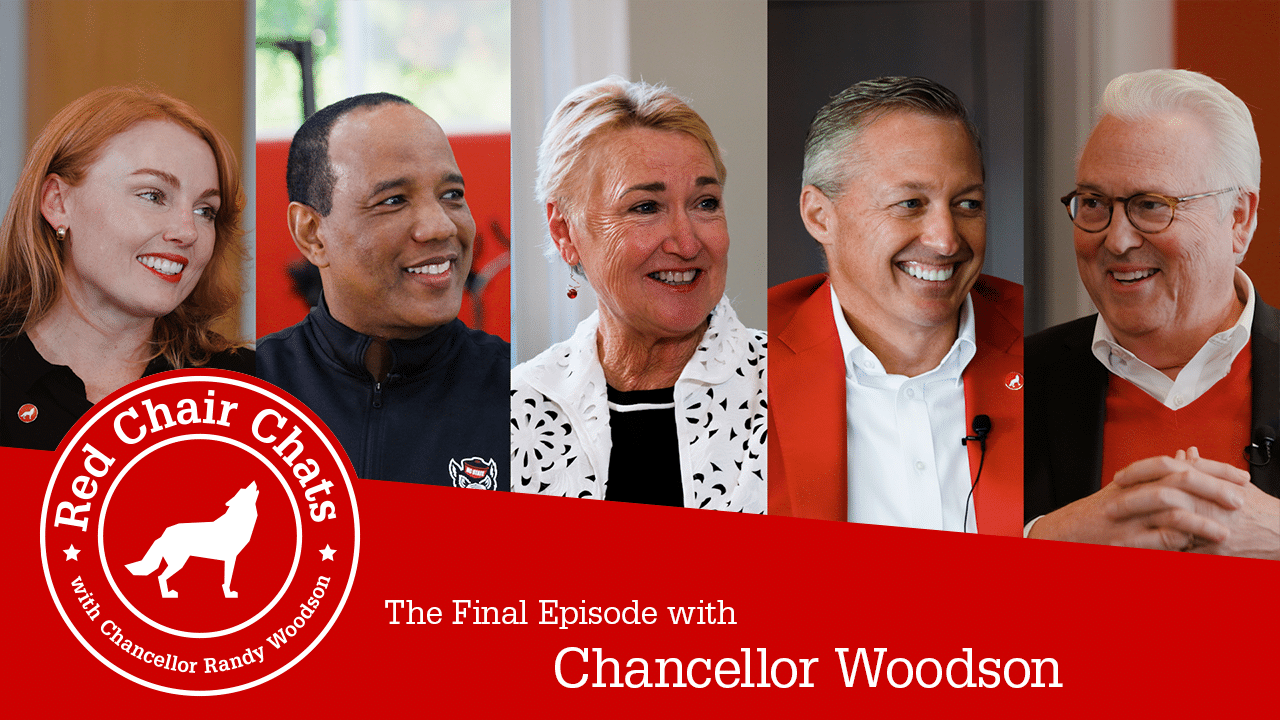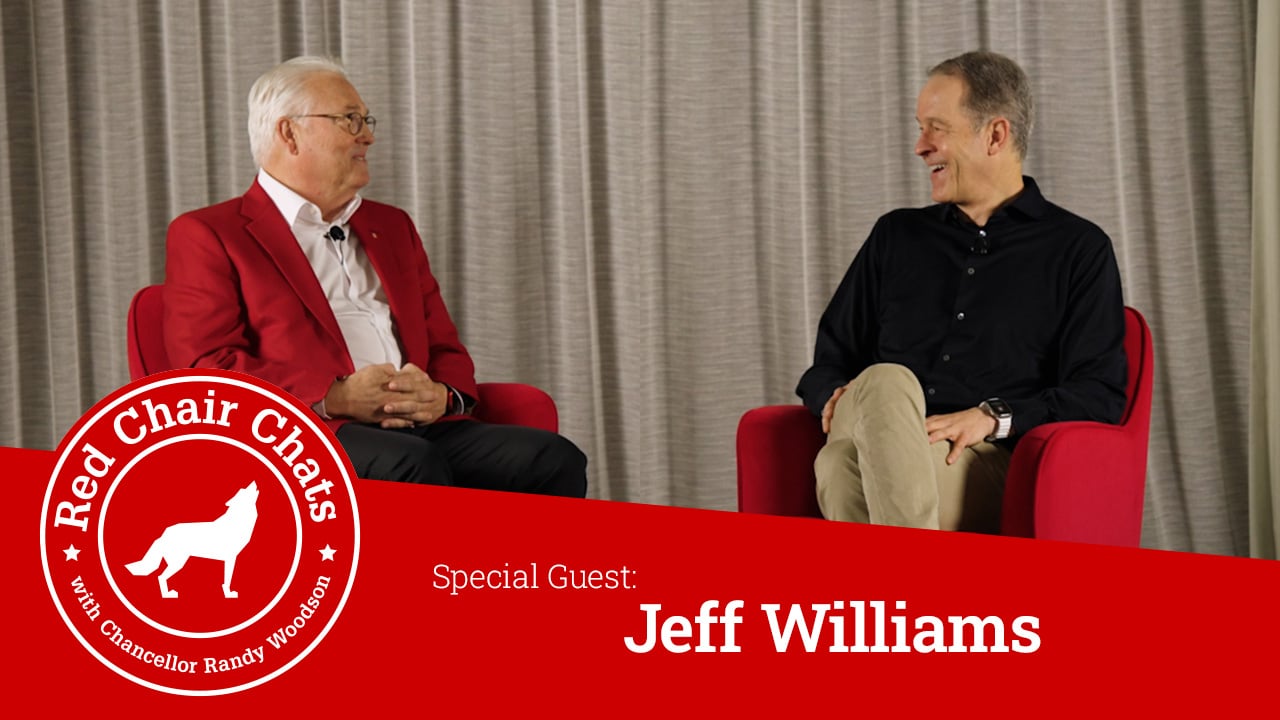Chancellor Woodson Talks Community and Design with Professor Kofi Boone
Chancellor Woodson is joined by Professor Kofi Boone at Chavis Park for a conversation about landscape architecture and environmental justice in episode five of Red Chair Chats.
Chancellor Randy Woodson sits down with distinguished professor of landscape architecture Kofi Boone at Raleigh’s historic Chavis Park for episode five of Red Chair Chats. In his 20 years with the NC State College of Design, Boone has worked to bridge the discipline of landscape architecture with social and environmental justice. He was recently awarded the Jot D. Carpenter Teaching Medal from the American Society of Landscape Architects.
Listen to This Episode
You can hear an audio version of this conversation on the Red Chair Chats podcast, available on Spotify and Apple Podcasts.
Transcript
Chancellor Woodson: Hello everyone. It’s Chancellor Randy Woodson here from NC State with another edition of Red Chair Chats, where we bring world-famous alumni, students, and faculty together to talk about all things Wolfpack. And today, we’re really excited to bring, for the first time for Red Chair Chats, a distinguished member of our faculty, Professor Kofi Boone. Kofi, welcome to Red Chair Chats.
Kofi Boone: Thank you, Randy. I appreciate it.
Chancellor Woodson: And Kofi, for those of you that don’t know, he’s a Distinguished Professor
of Landscape Architecture, where he does amazing work to bridge the discipline of landscape architecture with social justice, and in particular, environmental justice. So I’m really excited to sit down and talk with you today about everything you do in the community. But we got to start with what’s a landscape architect?
Kofi Boone: Yeah, that’s tough. I mean, my grandmother used to ask me what we did in the wintertime when it snowed, right? And I said, “Well, shovel snow,” you know, that kind of stuff. But that’s sort of the
stereotype that’s out there of our profession. I think maybe the easiest way to describe it is when you think of a building, you hire an architect, and you go through a process to figure out how to make the spaces, how to make it work, and hopefully how to make it sustainable over time. And it turns out landscape architecture is very similar except we focus on outdoor spaces.
So we focus on parks and community spaces, streets, you know the places we all convene in public. This space we’re in right now, Chavis Park. Our campus was designed by landscape architects. And so it’s one of those professions that has a very high impact. It doesn’t have as much visibility, but it’s getting more, because we’re focused on issues of the environment and climate and things that are really in our wheelhouse. So that’s what we do. We design and steward and protect outdoor spaces.
Chancellor Woodson: Well so, Kofi, you grew up in Detroit.
Kofi Boone: That’s right.
Chancellor Woodson: Motor City.
Kofi Boone: That’s right.
Chancellor Woodson: How does a kid growing up in Detroit even imagine that he wants to be a landscape architect?
Kofi Boone: Yeah, that’s a good question. So it’s, it was a circuitous path, right? It wasn’t direct. When I was in high school, I wanted to be a musician. And so there’s a performing arts high school in Michigan called Interlochen Academy of the Arts in northern Michigan. Literally in the woods, they used to call it “fame in the woods,” that’s kind of how it went. So I went up there expecting to learn how to move towards the symphony orchestra track and go and do that in college. But while I was in the woods, I discovered I had a love of nature. Had no idea. And I took a few ecology classes.
My mother and my grandfather were both artists. And so, in my brain, I was like, well, how do we connect art and nature? And they were, “Oh, don’t know. Go to the University of Michigan, go talk to somebody.” So I went to Michigan. I actually got recruited by the math department ’cause I had a high math SAT, and told this poor math professor — I feel bad for him now — I had no interest in math, but I kind of want to do something with art and nature. And they had the good graces to walk me over to the College of Natural Resources, and connect with the then-department head there. And so at that point, I was off to the races.
Chancellor Woodson: Well, that’s a lesson for all of us Wolfpackers. Think about getting out in nature. It can be a source of inspiration. In this case, a career of inspiration.
Kofi Boone: Right.
Chancellor Woodson: So talk a little bit about the space we’re in.
Kofi Boone: Sure.
Chancellor Woodson: Chavis Park is a critical park to many people in Raleigh.
Kofi Boone: Yes.
Chancellor Woodson: Long history.
Kofi Boone: Yeah.
Chancellor Woodson: Tell me how you’ve — why are we in this space today? And tell me the role you’ve played in this community development effort.
Kofi Boone: Sure, I’d love to. You know, I got to North Carolina and started teaching in 2004. Soon after that, learned about the legacy of the South and the fact that we really haven’t, in the academic research or professional space, really acknowledged the legacy of race on the landscape. And the fact that for a long period of time, a lot of where we’re sitting right now was impacted by slavery, plantations, but also sort of the triumphant stories. The Freedmen, who were the first Black and African Americans who were allowed to own property and actually bought property where we’re sitting right now as one of the first sort of self-established Black communities in Raleigh. So there’s been this long legacy of how the land has played a role. And so Chavis Park is interesting because at the time of its creation, it was started as the Negro Park. It was funded through the WPA and the federal government as the separate but equal facility to Pullen Park, which is right next to our campus. Privately donated the land, the funding, and all these things to create this wonderful amenity that we enjoy closer to NC State. The federal government actually funded what was known as the Negro Park, which we’re sitting in here today.
Early on, activists in the neighborhood advocated for renaming it John Chavis Park because of a very prominent resident, the first African American educator who was allowed to teach white and
Black students, lived nearby. And so they thought honoring his legacy was more appropriate. And so there you have it. So we have a carousel, it’s right next to us. They have a carousel in Pullen Park. Aquatics facility, aquatics facility here. And it went that way as these sort of parallel facilities until about the mid-20th century, and one of the important parts of it is, desegregation happened. It resulted in some disinvestment here, because the assumption was everyone could use Pullen Park, which is nearby. So more investment there, less investment here. But the surrounding community had a lot of cultural and historical ties to this place, memories that they created, relationships that they built that really weren’t visible, they didn’t feel were being celebrated.
So we come in, in the early 2010s, at the time when the South Park community, which we’re sitting in, was really concerned about the impacts of growth. Raleigh at that point was just getting ready to explode, and we’re right next to downtown. And they were concerned that they were going to lose their history, that that was going to result in the erasure of a lot of their stories and things they saw were important. So there were a number of researchers, Celen Pasalar in our college, and a number of others, we all kind of banded together and said, well how do we document and tell these stories in a way that can impact decision-making, with policy, and resources, and those kinds of things. So we kind of played that role of sort of technical support for that community vision. And it uncovered all of these amazing stories that we had no idea were important in this park.
So here we are at the heart of the park, heart of Chavis Park.
Chancellor Woodson: Yeah.
Kofi Boone: The historic center where all the activities that are really memorable about it, that are behind me are, are shown. The only remnant of it of the past is right behind us, the former carousel building.
Chancellor Woodson: Yeah.
Kofi Boone: But this work of art is attempting to frame it, provide a gateway as people move from the city into the park, and I think does it pretty well.
Chancellor Woodson: Yeah, That’s great.
Kofi Boone: And this is sort of the past and this is sort of the future and the present. There are a number of people in this picture who were even people we worked with. There’s, you know, this art is trying to interpret that in a contemporary way.
So we helped with that and we start learning that the Student Nonviolent Coordinating Committee, which is a world-famous organization, which was founded at Shaw University, right next door, started their activities in this park. So it has sort of this political history. Great musicians like Ella Fitzgerald and Billy Eckstein used to swim in the pool that was here.
Chancellor Woodson: Wow.
Kofi Boone: And there was just these amazing layers of history that no one knew. So we worked with the community to start to amplify those stories and locate where they were. That resulted in a designation on the National Register of Historic Places. The community voices that were a part of that really celebrated as evidence for that. So it’s sort of nationally recognized as a historic place. It gave momentum for a new master plan. They hadn’t had a new master plan since the 1970s. And so that directed what we’re sitting in now, the first phase of development that really is designed to honor from the mural behind us to the other places, really infusing this place with that history.
Chancellor Woodson: It strikes me as a professional in a very technical field, like landscape architecture, where you have to be precise in your measurements, and precise in the way you structure the land, that everything that you just described is very humanist. It’s very interactive with the population that informs your design. It informs the work that you do.
Kofi Boone: Yeah.
Chancellor Woodson: Talk about how important it is, as a landscape architect that’s focused on environmental justice, how important it is for you to communicate to your students the importance of this interaction, the importance of community engagement, what it brings to your discipline. Because again, Kofi, everything you just described is a very social science-driven process that informs your technical.
Kofi Boone: Yeah, it’s a great, great question. I mean, I think that, when I think of technical knowledge, we think about specialized training, and we think about sort of discreet boxes where we deal with information and research as being sort of these empirically proven, reproducible kind of acts that, no matter who does that process, they’re going to get the same result. That’s how scientific method kind of works. So, we’re dealing with peopl,e though. People are a totally different animal, literally.
Chancellor Woodson: They are.
Kofi Boone: So, and it turns out that the environmental justice movement, which the mainstream environmental justice movement started an hour away from where we’re sitting in Warren County, North
Carolina, after the PCB landfills in 1982.
Chancellor Woodson: Oh, yeah.
Kofi Boone: That, it started as sort of a resistance movement, was saying that, look all of these scientific processes you think are rational, are making sense, and are well thought out are actually having a negative impact. Not just a negative impact on everybody, on a very specific group of people, particularly Black and brown people and low-income folks. So this rational process is producing and reproducing this negative result in our community. So is there a way for us to have our voices heard? It’s a faster sort of feedback loop of saying that, hey we’re experiencing the brunt of these things, what if we were at the table making these particular decisions with you? You could benefit from what we’re experiencing on the ground.
And so that’s sort of how these two fit together. And so we’re learning that not just locally, and not just regionally, but globally. Like we’re finishing the COP27 global climate conversations, and it’s the same thing happening globally, which is to say that the people who are most vulnerable to any changes we’re making in the environment, there’s a reason why they should be at the table. They should have a voice and actually have some power in the decision-making. So when we talk about technical knowledge and community knowledge, we’re trying to get the best of both worlds. We’re trying to say that there is a place for the rational and scientific side, the reproducible result, the evidence-based decision-making. But there’s a variable in terms of how people perceive it, their experience with it, things that we can’t find or sense from any of our scientific methods that they have, based on their cultural traditions. And it’s really wedding those, finding ways to wed those, that produces the best work that is, that will last. Like people will actually care about it and be invested in what we do.
Chancellor Woodson: Well, I know recently it came across my screen — we all get information from a screen — that Professor Kofi Boone just was honored by the American Association of Landscape Architects with the Outstanding Teaching Award for that organization. So listening to you today, it’s clear why you’ve received that award. But talk a little bit about how you interact with students in the classroom and build this kind of framework of empathy for the people in the community that you’re serving through your profession.
Kofi Boone: No, it’s a great question. Very honored to have received that award. People who know me well know as a Michigan grad, I was a little bit sheepish, because it’s named after an Ohio State professor.
Chancellor Woodson: That’s tough.
Kofi Boone: But I took it with grace and a smile on my face. But I appreciate it. But, you know, that award is really a tribute to the students. So, that’s the evidence of teaching is when they go out into the world and they do great work. That makes me happier than any individual accomplishment I have. But, the classroom is sort of a place, and particularly in design, it’s a rare opportunity where we can engage everyone in not just defining a solution, but working together to define the actual problem we’re trying to solve. So it’s almost a cheat code. Other professions don’t like design for that reason. It’s like, ‘That’s not fair. You can’t change the problem that you’re trying to solve midstream.’ Well, that happens all the time in design. We start, like, one way. We think that the problem is X, Y and Z. You start engaging community, getting data, and you’re like, well we need to pump the brakes a little bit. Maybe it’s A, B and C. So the students get the opportunity to engage in that kind of conversation. Not just in a one-way street of me as the expert and them as sort of the novice. Although there is some technical knowledge as we went back to that, that just because I’m old, I know a little bit more about the technical side.
Chancellor Woodson: It’s a great thing about age.
Kofi Boone: Yeah right, exactly. Yeah, we can talk about that in another Red Chair talk. But, the other side of it is innovation, and the idea that if you put students and even people without a lot of information, and this comes from community work, the idea that me, as a technical expert, doesn’t mean I monopolize the potential for innovation. Innovation can come from anywhere. And it always happens when there’s students who are faced with some of these challenges that, based on their experience and what they’ve seen, and sometimes from a naive standpoint, not being overburdened by too much knowledge, they see a different pathway. They see a different way of framing a problem. They reach out to different examples. They show initiative and talk about how to infuse their experiences.
And so we try and foster that in the classroom and then deliver it to a result. So our challenge in the classroom is that we still have to produce students who are technically competent. We don’t want people who are incompetent going out in the world and doing harm. But, what we’ve noticed is there’s a groundswell now of students who want to make a difference, not in the long term but, like, right now. They want to feel like they’re a part of the solution. They want to think that when they leave they won’t be seen as an agent of harm elsewhere. And so, our goal is to kind of foster that setting that enables ’em to do their best in that.
Chancellor Woodson: Well, my wife reminded me this morning that I’m not overburdened by too much knowledge. I still have room to accumulate a little more.
Kofi Boone: Right, right.
Chancellor Woodson: Tell me, how do you relax in Raleigh? You’ve been here for almost 20 years. You came here from the big city. What about Raleigh inspires you? Where do you find time to unwind?
Kofi Boone: You know, that’s a good question. I spend a lot of time at the Museum of Art in the Art Park there. That’s something that’s really grown and blossomed since I’ve been here. Almost every year they’ve got a new program, they’ve got a new addition. It’s getting bigger and better. So, it has the nice marriage of, I think, really great landscape architecture, really inspiring art and creativity, wide section of people. I like that it’s free. That’s, like, a value to me. So when I’m in Raleigh, that’s what I do.
Chancellor Woodson: So you mentioned when we started the conversation that you went to Interlochen thinking that you were going to be the world-class musician. Are you still, do you still practice music?
Kofi Boone: Well, when I do, I play French horn. My teenage kids politely call ’em elephant farts.
Chancellor Woodson: Do they really?
Kofi Boone: So, yeah, yeah. So, I would say no.
Chancellor Woodson: Teenagers are so-
Kofi Boone: Teenagers are very, very direct.
Chancellor Woodson: Yeah, yeah.
Kofi Boone: But I do have a-
Chancellor Woodson: I’ve actually never heard an elephant fart.
Kofi Boone: They haven’t either, so I’m trying to figure out how they even know. But, but no, I have a friends group and we trade music from time to time. So I have more success with my peers than my kids. They’re a harsh audience, yeah.
Chancellor Woodson: All right, what other bits of wisdom would you like to leave the Wolfpack with today?
Kofi Boone: Yeah, I think that community is a very difficult conversation now. In a lot of ways, we’re very polarized. And in a lot of ways we’ve been privy to information that can lead to a lot of anxiety. A lot of our students, in fact, have climate anxiety which is to say, a fear that, in a generation, if things don’t change rapidly, the world we’re going to be living in is just going to be really different, and we’re going to have a lot of compromises. And so I think that this is different than when I was in school.
Chancellor Woodson: Right.
Kofi Boone: I went to the University of Michigan. There was still a belief that the system we were in, it was just a matter of sort of perfecting and tweaking and reforming. I think this generation, it’s going to require bold action to redirect where we’re going to avert the harms that could come in the future. So I think it places more of an emphasis on skillsets that we don’t often talk about as educators and teachers, people’s mental health and well-being probably being at the top of the list. And making sure that we’re achieving our goals, but also cognizant of the fact that this generation is existing in a world that is very different from ours, and having some empathy for that. So, I think my hope is that we keep moving in that direction, that we get better at it, and that our students feel like there is hope for a brighter future.
Chancellor Woodson: Well, you gave our students hope this fall. Professor Boone was the featured speaker at Convocation. So he had before him 5,600 new freshmen, 1,500 transfer students that you had a great message for. Give our audience a sense of the hope that you gave to our students on that day.
Kofi Boone: I have a lot of hope in this generation. I think, just from a personal standpoint, I have two teenagers in my own home. And I have to be hopeful for them and believe that they’re going to inherit a brighter future. I think that university and college for me has meant dealing with bias and dealing with preconceived notions of how people are and what they do, and being open enough to admit that we have biases, but then once we’ve admitted ’em, sort of confronting ’em. And so, what I hoped for our incoming class is that it would be a time where they get the technical skills that are required, but they start to build that skillset to build community wherever they are.
Chancellor Woodson: Yeah.
Kofi Boone: And part of that is acknowledging difference, learning to negotiate it. That’s all critical for us to move forward. So I wish for that class the ability to do that.
Chancellor Woodson: It was great advice. Well, Professor Boone has been great to be with you today. Thank you for sharing so much insight with our community. Another great edition of Red Chair Chats, so I hope you’ll join us next time. Until then, go Pack.
Kofi Boone: Go Pack.
- Categories:



